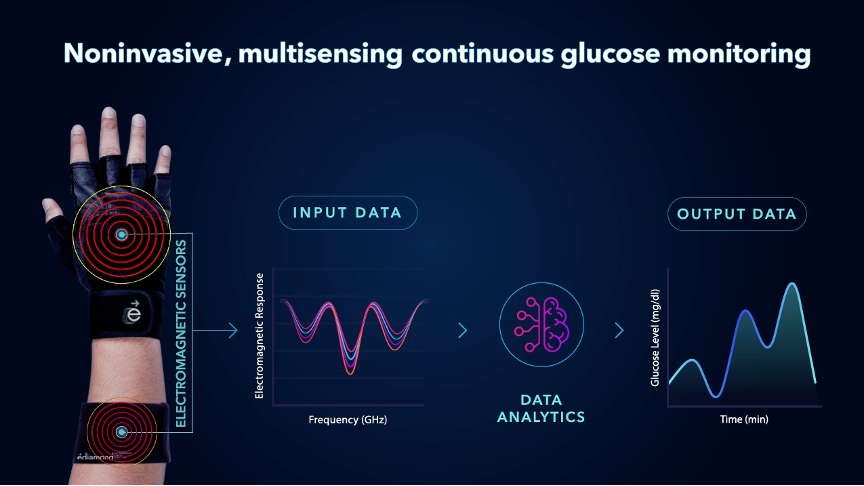 Health & Physiology
Health & Physiology
eDiamond: A life-changing glucose monitoring solution for diabetics
Needle-free wearable apparels for continuous glucose monitoring are the “holy grail” solution for diabetic patients. In our work, we leveraged wireless waves for continuous glucose monitoring. eDiamond allows patients to monitor their blood glucose variations noninvasively and continuously at any time, by simply wearing a glove or an arm band.

Diabetes is a chronic disease that affects more than 8.5% of the worldwide population. People with diabetes are at risk of serious health problems arising from diabetes-related complications. Monitoring of blood glucose levels as often as possible is crucial to managing diabetes.
The standard technique to check blood glucose levels uses a glucometer, which is considered the most accurate device on the market today. However, a glucometer requires patients to prick their fingers to draw small drops of blood, which is both painful and uncomfortable. Moreover, this technology is unable to provide continuous glucose monitoring, which can result in the patient missing incidents of hyperglycemic and hypoglycemic between finger-prick measurements. Therefore, the development of an affordable, non-invasive, continuous glucose-monitoring device will be life changing for millions of diabetic patients worldwide.
Noninvasive solutions use various techniques. Electromagnetic waves are one of the leading technologies to achieve noninvasive and continuous glucose monitoring. But how do they sense glucose levels in the blood?
When electromagnetic waves are transmitted to the body, they interact with the tissues and can provide important information of their properties. Every biological tissue has a unique electric signature, which can be affected by the concentration of medically relevant biomolecules such as glucose. More precisely, the changes in the way electromagnetic waves are reflected and transmitted are associated with the glucose fluctuations. By monitoring and analyzing these changes, we can reveal variations in blood glucose levels.
In our recent study, we introduce a novel glucose monitoring system, eDiamond, which uses electromagnetic waves to directly monitor blood glucose levels. Our system consists of a glove and an arm band that can continuously monitor blood glucose variations. The design of the sensors integrated inside the glove and the arm band mimics the arteries and veins network of the hand and arm respectively. By directing the electromagnetic waves from our system specifically toward the blood network, we achieved a level of higher sensitivity. Furthermore, the system can be personalized to fit the needs and preferences of each patient.
We tested the system on serum, animal tissues, animal models of diabetes, and in clinical trials. Serum and tissue experiments demonstrated high precision across the diabetic glucose range (10 - 600 milligrams/deciliter). Experiments on diabetic rats detected the glucose levels with 97% diagnostic accuracy over a wide range of glucose variations. Human trials exhibited a clinical accuracy of 98% in thirty-three subjects. Currently, the system is being tested on a small group of diabetic patients, and early results also show it reports glucose levels with high accuracy. The system still needs to be tested under different physiological conditions, for example during or after exercise.
The glove and the armband are just two examples of a series of accessories that the eDiamond team is developing, including sensing socks for babies and sensing necklaces for adults, as well as additional models of the glove and armband tailored for athletes.
This is a ground breaking study that assesses the sensitivity of new-class sensors on serum, animal tissues exposed to a wide range of glucose concentrations, animals with diabetes and in a clinical trial. A continuous non-invasive solution for monitoring blood glucose levels enhances the quality of life for millions of diabetic patients. Furthermore, it opens the door for the development of an artificial pancreas that will work - like a healthy biological one - without the patient's intervention. The future of less restricting glucose monitoring has dawned with the introduction of eDiamond.
Acknowledgment to Prof. Joseph Costantine, Prof. Rouwaida Kanj, Prof. Assaad Eid and Prof. Youssef Tawk who edited this article.
Original Article:
Hanna, J. et al. Noninvasive, wearable, and tunable electromagnetic multisensing system for continuous glucose monitoring, mimicking vasculature anatomy. Sci. Adv. 6, 1-12 (2020).
Next read: Tougher than expected: insulin’s surprising thermostability expands diabetes patients’ hope in tropical countries by Sara Pannilunghi
Edited by:
Dr. Ayala Sela , Associate Editor
We thought you might like
A new paradigm for metabolic health: reduced intake of dietary branched-chain amino acids
Feb 22, 2018 in Health & Physiology | 3 min read by Dudley W. LammingThe surprising effects of a Paleo diet on diabetic patients
Dec 14, 2016 in Health & Physiology | 3 min read by Alice MatoneStudies of the bugs within: telling sickness from cure
Mar 20, 2018 in Microbiology | 4 min read by Sofia K. Forslund , Oluf PedersenMore from Health & Physiology
Tobacco smoking and other exposures shut off cancer-fighting genes
Aug 31, 2024 in Health & Physiology | 3 min read by Jüri Reimand , Nina AdlerA hidden clock that times cytoplasmic divisions
Aug 30, 2024 in Health & Physiology | 3 min read by Cindy OwWhen two kinases go for a dance
Aug 2, 2024 in Health & Physiology | 4 min read by Ioannis Galdadas , Francesco Luigi Gervasio , Pauline JuyouxAwakening the thymus to cure SARS-CoV-2 infection: a matter of genes
Jul 27, 2024 in Health & Physiology | 3.5 min read by Stefano Marullo , Cheynier RemiKeeping the balance: How epigenetics monitors cancer genes
May 13, 2024 in Health & Physiology | 4 min read by Zach Gray , Madison Honer , Johnathan WhetstineEditor's picks
Trending now
Popular topics


